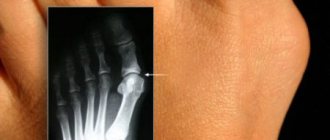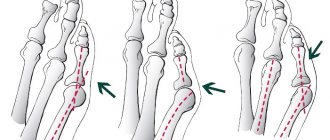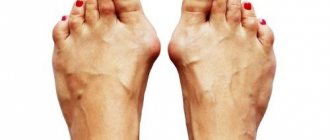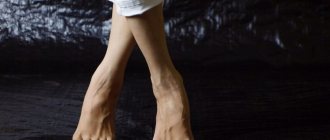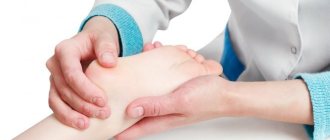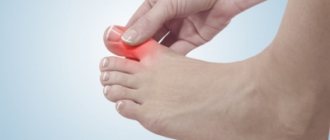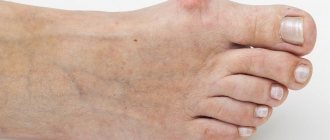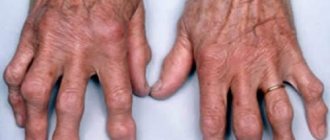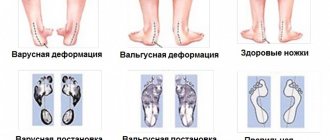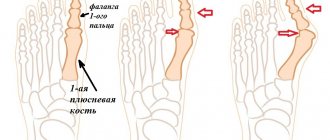General issues
Bone on the big toe: why it grew, stages of development, treatment methods
08/09/2018 Arina Sokh No Comments
A bunion on the big toe is not only an aesthetic problem for women. It also occurs in men. The medical name for the disease is hallux valgus, or hallux valgus (literally translated from Latin as “crooked big toe”). Uncomfortable shoes are not the only cause of hallux valgus. This problem is created by other disorders that affect the biomechanics of the arch of the foot. Let's find out why a bump on the leg occurs, how to treat it and what is needed for prevention.
Why do bumps grow on my feet near my big toes?
During instrumental examinations, it is clear that the bone on the big toe changes its angle. An X-ray examination, MRI or CT scan shows a narrowing of the joint space and hardening of the soft tissues.
How to massage a bunion on your big toe
The most common problem of the disease is transverse flatfoot (“flattening” of the foot). This is the main reason leading to subluxation. This is how an osteochondral growth is formed, also known as a protruding lump. In essence, this is a deviation of the metatarsal bones from the physiological state (most often it affects the big toe and little finger). If the curvature is severe, the remaining fingers suffer.
Bunions on the big toe are a cosmetic nuisance. However, a bump on the leg provokes complications. Possible reasons will tell you why the bone on the foot is growing. This:
- congenital deformities of the foot (transverse flatfoot, curvature of its posterior part, looseness of the first anterotarsal joint);
- professional activities or sports that increase the load on the feet;
- genetic predisposition;
- weakness of the ligaments (connective tissue dysplasia in congenital diseases: Down syndrome, cerebral palsy, Marfan syndrome, Charcot-Marie-Tooth disease and others);
- hypermobility (excessive mobility) of the first metatarsal joint;
- thumb too long;
- joint diseases (arthritis, arthrosis);
- chronic diseases that provoke insufficient blood supply to the feet (diabetes mellitus, gout, atherosclerosis, hypothyroidism);
- suffered leg injuries.
Bone in the thumb: is there any point in having surgery?
Children and teenagers rarely have this problem. Most often the disease occurs by age 30. The reasons why it hurts and a bone grows on the leg are different for each person. But you don’t need to treat yourself without consulting a doctor.
Moreover, you cannot treat baby bumps or bumps on the feet of a child of any age yourself, using photos from the Internet. To identify the cause, you will need to consult a pediatric orthopedist. This pathology is unusual for children, which is why consultation with a specialist is required. This will help you notice and solve a possible problem in time.
A detailed diagnosis will help you understand what caused the bumps on your legs. The patient will need to undergo the following tests:
- radiography (performed in several projections);
- computer plantography;
- biomechanical examination;
- MRI and CT.
What to do if the bone on your big toe begins to deform.
The results of the examination help to identify why the deformity occurred and what stage it is at.
This will help you get rid of a bunion on your big toe quickly and without complications.
Modern methods of eliminating diseased foot bones
In modern orthopedic operations, bone fragments are cut out and moved to eliminate the diseased bone and give the correct position to the big toe. The finger is fixed with medical screws or knitting needles until final fusion.
There is another treatment option - “closure” of the deformed joint. Orthopedic surgeons remove the cartilage completely and reattach the metatarsal bone to the first phalanx of the big toe in the correct position. As a result, the bone and pain disappear.
Considering what was described above, we can say that a surgical revolution has occurred in the treatment of diseased bones. The most important thing is that the attitude towards the problem and the very essence of treatment have changed. If in the past a deformity of the thumb was considered a defect of one joint and its bones, today an integrated approach is used in the fight against the bunion.
Nowadays, orthopedic surgeons, even taking into account the operation, can rehabilitate a patient in one day. The next day, people begin to walk on their own, albeit with more support on the heel and the outer edge of the foot, but without a cast or crutches. After two weeks, the sutures are removed, and after 1-1.5 months the patient returns to his usual lifestyle, but without pain in the foot.
We can say that modern operations have virtually no disadvantages. Unfortunately, they are not made everywhere. There is a shortage of highly qualified surgeons and special, high-quality, and therefore expensive, equipment. The situation is the same in other countries, but at a much higher cost for surgery on the leg bone.
Types and stages of pathology
The patient should be alerted to a neoplasm, any growth or growth on the bone of the foot. The appearance of a lump on the legs near the big toe does not indicate the first stage of pathology. Painful sensations can appear after physical activity, even at rest.
The growth of a bone at a leg joint has several phases:
- Slight redness of the joint, the angle of deviation of the finger is no more than 15°. The patient may notice discomfort in the fingers. There are no painful sensations.
- Formation of a hard lump, painful corns on the sole. The finger deviation angle is more than 20◦. I am worried about pain after physical activity or wearing shoes.
- The bone on the side of the foot deviates so much that it is difficult to wear ordinary shoes. The angle is more than 30◦. Deformation of other fingers occurs. Growths and calluses appear on them.
- It becomes almost impossible to walk due to pain in the deformed foot, the angle of deviation of the toe is more than 35°.
In the first two stages, the disease can be slowed down and the patient’s condition can be significantly improved. For this purpose, conservative techniques are used. If foot deformities are already in an advanced stage, only surgical intervention will help. Drug treatment, physiotherapy, and massage are usually prescribed during the recovery phase to restore the physiological state of the foot.
Peculiarities
When there is a painful bulge on the outside of the foot at the base of the little toe, podiatrists diagnose Taylor's deformity, or "tailor's disease." For the first time, a detailed description and diagnosis was carried out by the American specialist H. Davis in 1949, noting complete identity with the development of Hallux Valgus.
An inflamed area forms on the lateral surface of the head of the little finger bone, causing the finger to deviate inward. The pain can radiate to the lateral part of the foot and provoke inflammation of the ligaments, bone and cartilage tissue. Characteristics:
- the forefoot expands, the angle between the 4th and 5th toes increases;
- the little finger takes on the shape of an arc; with the varus subtype, it can overlap the ring finger in a cruciform manner;
- a “bone” is formed on the outside.
For a long time, the pathology develops asymptomatically. The foot gradually increases in volume due to a growth, an increase in the fourth intermetatarsal angle. Conservative treatment eliminates the disease only at the initial stage. In most cases, surgery is performed using different methods.
What is the danger of a lump on the foot near the big toe?
A bunion on the big toe creates a risk of problems. As a result, a growing bump appears (a bone grows on the side). This pathology provokes:
- redness, burning, swelling of the first finger;
- ingrown nail plates;
- felon;
- change in gait;
- arthritis;
- arthrosis;
- pain in the back, knees.
It becomes impossible to move independently and wear regular shoes.
If foot deformities are already in an advanced stage, only surgical intervention will help.
When a bunion grows, the patient’s psychological state also worsens. At the last stage, the problem can only be solved surgically. After the stitches are removed and the rehabilitation period is over, you can return to a full life. One of the advantages of radical therapy is that the valgus deformity will not reoccur.
Preparing for surgery
In most cases, manipulations are performed under spinal anesthesia. To exclude complications and develop a surgical plan, the patient is prescribed the following preparatory procedures:
- radiography of the foot in two projections;
- blood chemistry;
- coagulogram;
- tests for sexually transmitted diseases, HIV, hepatitis C;
- Ultrasound of the lower extremities;
- X-ray of the chest and respiratory organs.
For chronic diseases of the cardiovascular and endocrine systems, additional consultation and examination by specialized doctors is required.
How to remove a lump on the big toe using surgery
The only option that can help with an existing bunion on the big toe is radical correction. Orthopedics involves more than 250 methods of surgical therapy.
The main goal of surgical correction of a bunion on the big toe is to eliminate the unnatural angle of the metatarsal bones. This correction is indicated at stages 2–4. Afterwards, therapeutic treatment continues to restore full function of the feet.
Orthopedics involves more than 250 methods of surgical therapy.
Radical correction is needed if:
- the musculoskeletal function of one or both feet is impaired;
- it is necessary to eliminate the aesthetic defect (for example, the inability to wear open shoes).
The most common operations are on bones. They are used for complete or partial removal of a cone on the feet near the big toe or complete resection (removal) of growths on the bone. For complex deformities, a combined correction will be required. It additionally involves strengthening the ligaments.
Commonly used surgical techniques:
- Minimally invasive correction, which is possible only at an early stage of changing the shape of the foot. The removed bump on the big toe disappears without noticeable scars that remain after the stitches. The intervention is carried out through tiny incisions (up to 3 millimeters), without damaging muscles and blood vessels. The main tools are a microscalpel and a microsaw. With their help, correction is carried out under radiographic control. No screws, brackets or plates are needed. The advantages of the technique are a shortened recovery period, no postoperative bandage is needed, almost no pain or swelling.
- Reconstructive method, or osteotomy, which is indicated for 2–4 degrees of valgus deformity. This is a rather traumatic method that involves open intervention on the foot. After dissecting the skin and joint capsule, the “bump” on the big toe is excised. If necessary, file the protruding metatarsal bone. The bones are held in the correct position using titanium brackets or screws. The postoperative period includes mandatory wearing of insoles and fixation with a bandage. Swelling of the feet persists for 2-3 weeks; it is recommended to wear orthopedic shoes.
The reconstructive method, or osteotomy, which is indicated for degrees 2–4 of hallux valgus.
Osteotomy is performed under general anesthesia; after the operation you will need to stay in the hospital for 1-2 days. You can stand and walk on the second day. Features of the recovery period depend on what kind of operation was performed. The least traumatic operation in this sense is minimally invasive.
Rehabilitation period after surgery
On the first day, the patient is recommended to remain in the clinic under the supervision of a surgeon. The patient is fitted with special orthoses - Baruk boots, which, when walking, relieve the load from the forefoot and toes on the heel. These shoes must be worn for at least 6 weeks. In a difficult situation, you can additionally rely on crutches and limit physical activity.
After surgery, for 2 weeks it is recommended:
- bed rest;
- place a pillow or cushion under your feet to stimulate the outflow of excess fluid;
- for severe pain, apply cold compresses for 30 minutes up to 4 times a day.
To reduce pain, the doctor selects medications individually and calculates the dosage for home use. Swelling begins to decrease on the 3rd–5th day after surgery. After 14 days, it is recommended to visit the surgeon again to remove the skin sutures.
After 6 weeks, the patient is sent for a repeat x-ray. With pronounced positive dynamics and the absence of contraindications, walking without corrective orthoses with a load on the toes is allowed.
In some older patients, swelling may persist for a long time, which is associated with decreased tone of the veins of the extremities. In such a situation, lymphotropic therapy and contrast foot baths are prescribed.
Insoles, bandages as ways to help with overgrown bunions on the foot
Even during treatment, the bone in the foot grows, since the tension on the feet remains (while walking, standing). There are devices that support deformed bones in the desired position:
- insoles, also called instep supports;
- fixing bandage;
- silicone earbuds.
In essence, bandages and clamps act as an orthosis. When a bunion grows, during the daytime the doctor recommends insoles and silicone inserts. The bandage supports the subluxated bone in the foot.
A lump grew like a mole on my leg. Hallux valgus
Advantages of minimally invasive techniques
With early treatment, in 80% of cases, surgeons prescribe low-traumatic foot surgeries. The work is carried out through small incisions or pinhole punctures. Advantages of the methods:
- allow you to correct complex deformities in one procedure;
- give predictable results;
- You can operate on two feet at the same time;
- with the percutaneous technique, the patient can stand on his feet and move freely from the first day;
- no plaster cast or crutches are required.
Minimally invasive operations are highly specialized and are performed by highly qualified orthopedic surgeons using a special technical base.
Surgeries for Taylor deformity take from 25 minutes to an hour and can be performed on both legs simultaneously. In most cases, there is no significant blood loss, which shortens the rehabilitation period.
How to properly massage the bumps on your feet near your big toe
If a bunion occurs on the foot, therapeutic massage is considered a productive method - part of the conservative treatment of a protruding bunion, if a bone protrudes on the foot.
Several self-massage and foot warm-up techniques to perform at home:
- squeeze and unclench your toes (up to 10 repetitions);
- spread the fingers in the form of a “fan”, return to their natural state);
- protrude the big toe back to normal with your hands.
It is important to select a massage complex after consultation with an arthrologist or surgeon. Afterwards it can be combined with home self-massage.
Contraindications for surgery
Absolute or temporary restrictions for performing an osteotomy on the foot are:
- osteoporosis and reduced bone tissue regeneration;
- exacerbation of rheumatoid arthritis;
- obesity 3-4 degrees;
- acute stage of infectious diseases.
Minimally invasive surgeries are allowed for varicose veins and joint bursitis.
Taylor syndrome leads to the formation of a painful growth at the base of the little finger, swelling, and calluses. New methods of surgical treatment can relieve the patient of complications and restore lightness to his gait.
Prevention of the problem
There is a particular risk of hallux valgus if your work or lifestyle puts a lot of stress on your feet. To avoid a bump on your leg, as in the photo of bumps on your legs, it is important to follow simple prevention tips. If a child is professionally involved in sports or dancing, any complaints of discomfort or tumors are a reason for parents to be wary.
If you are at risk, after 30 years it is important to pay special attention to the health of your feet:
- choose comfortable shoes (especially casual ones);
- In the evening it is recommended to take relaxing foot baths with sea salt;
- to strengthen your feet, you should do simple exercises every day (it is advisable to select them together with an orthopedist);
- It is useful to do self-massage of the feet;
- A balanced diet helps prevent joint problems.
What to do with bunions is not a decision you can make on your own. When a lump appears, you need to visit a doctor as soon as possible to maintain the health of your feet.
Causes of the disease
The pathology is often hereditary; if the parents had hallux valgus, there is a high probability of its occurrence in children. But there are a number of other factors that may contribute to this:
- wearing uncomfortable, narrow shoes, especially high heels;
- excess weight and excessive load on the musculoskeletal system;
- inflammatory processes in the joints;
- previous injuries;
- weak muscles and ligaments of the lower extremities;
- osteoporosis;
- rickets;
- abnormal development of the foot, etc.
The disease is often provoked by hormonal changes in women over 30 years of age due to a decrease in the production of estrogens, which affect connective tissue.

